Zebra Technologies PLAN11BG Zebra Printer with Embedded b/G radio User Manual UMAN P4TB3
Zebra Technologies Corporation Zebra Printer with Embedded b/G radio UMAN P4TB3
Contents
- 1. Users Manual Part 1 of 4
- 2. Users Manual Part 2 of 4
- 3. Users Manual Part 3 of 4
- 4. Users Manual Part 4 of 4
Users Manual Part 2 of 4
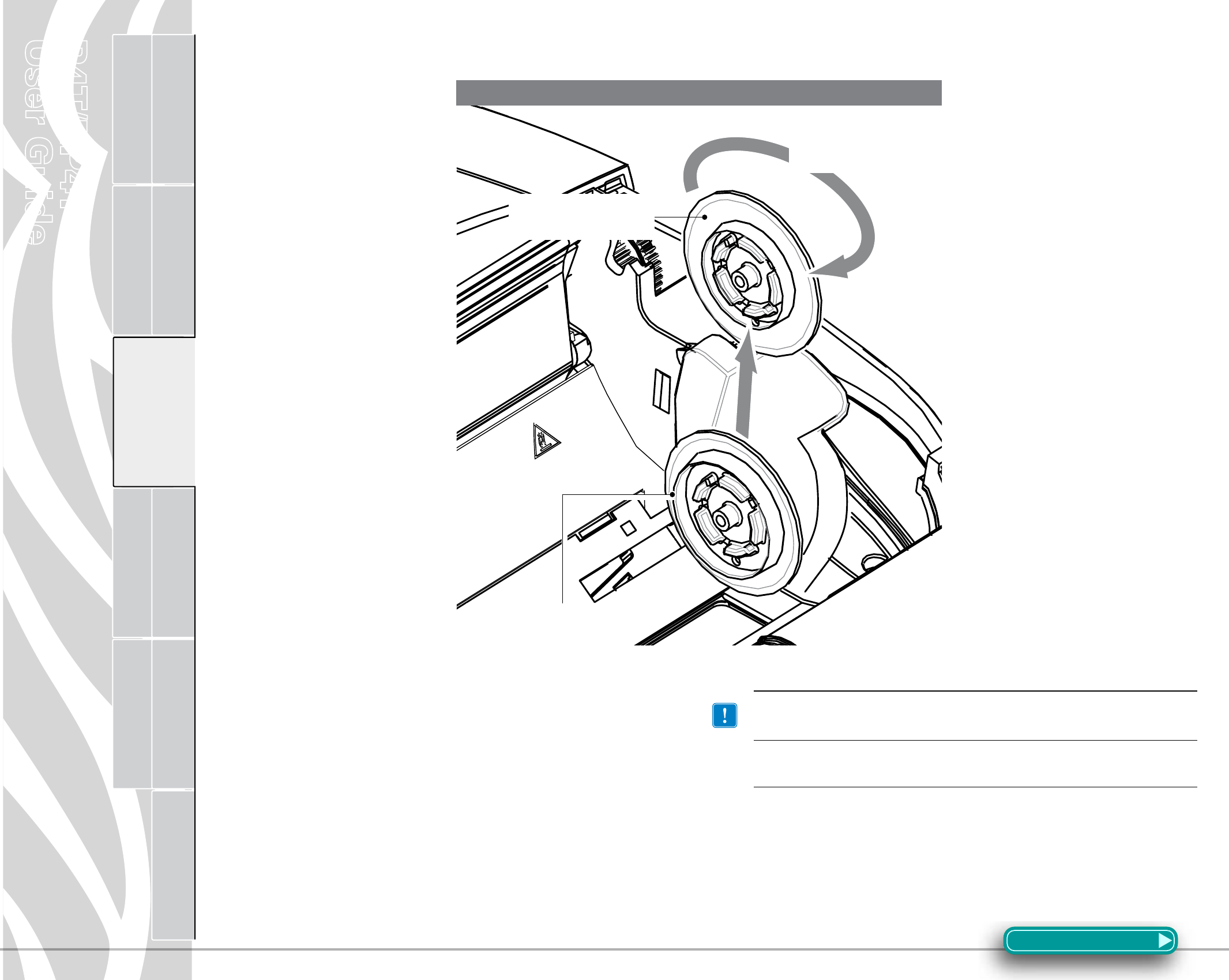
P4T/RP4T
User Guide
16
Printer Preparation Connecting the
Printer
Radio Regulatory
Information
RP4T Printers Maintenance Troubleshooting Specifications Appendices Index
P4T Overview
Manual
Introduction
Adjusting The Media Support Disks
Media Core Size
MediasuppliedfortheP4TSe-
ries printers will have two pos-
sible core sizes, depending on
the media type. Journal media
and most label media is supplied
witha0.75”[19.1mm]diameter
core to maximize the amount of
media contained on a roll.
P4Tprintermediasupportsare
setatthefactoryfor0.75”diam-
eter media cores.
RP4T printers (equipped with
theRFIDencoder)arecongured
formediawith1.38”[35.05mm]
diametercoressinceRFIDme-
dia cannot be wound around
a small diameter core without
both degrading its ability to feed
properly past the printhead and
causing possible damage to the
embeddedRFIDcircuitry.
Changing The Media Support
Core Diameter Size
It may become necessary to
change the media core size in
the field to allow use of different
media.
The media support disks are
designed for both sizes of media
cores, and they can be adjusted
by removing them, flipping their
position and re-securing them to
the printer.
1. Open the Media Cover and
remove any label media.
2.UsePhillipsheadscrewdriver
with a long blade to keep the
screwattachingtheSupportDisk
to the printer from turning.
3.RotatetheSupportDiskwhile
keeping the attachment screw
from turning, and remove it.
4. Flip the Media Support Disk
so that the desired core diameter
ridge faces towards the inside of
theprinter.PleaserefertoFigure8.
5.Re-securetheSupportDiskbytighten-
ingitontotheattachingscrew.Donotover
tightentheSupportDisk.Itmustbeabletospin
freely.
RepeatthisprocedureontheotherSupportDisk.
AlwaysensurethatbothSupportDisksareadjustedforthe
samesizemediacore.
ReplacetheMediaSuppor tDisksiftheyhavebeenadjusted
fordifferentcoresizesmorethan5(ve)times.
Figure 8- Adjusting the Media Core Diameter
Section Continues
Media Support Disk
(shown adjusted for 1 3/8”
label media core)
Media Support Disk
(shown re-adjusted for
3/4” label media core)
Remove Support Disk,
and flip it 180° to change
core size.
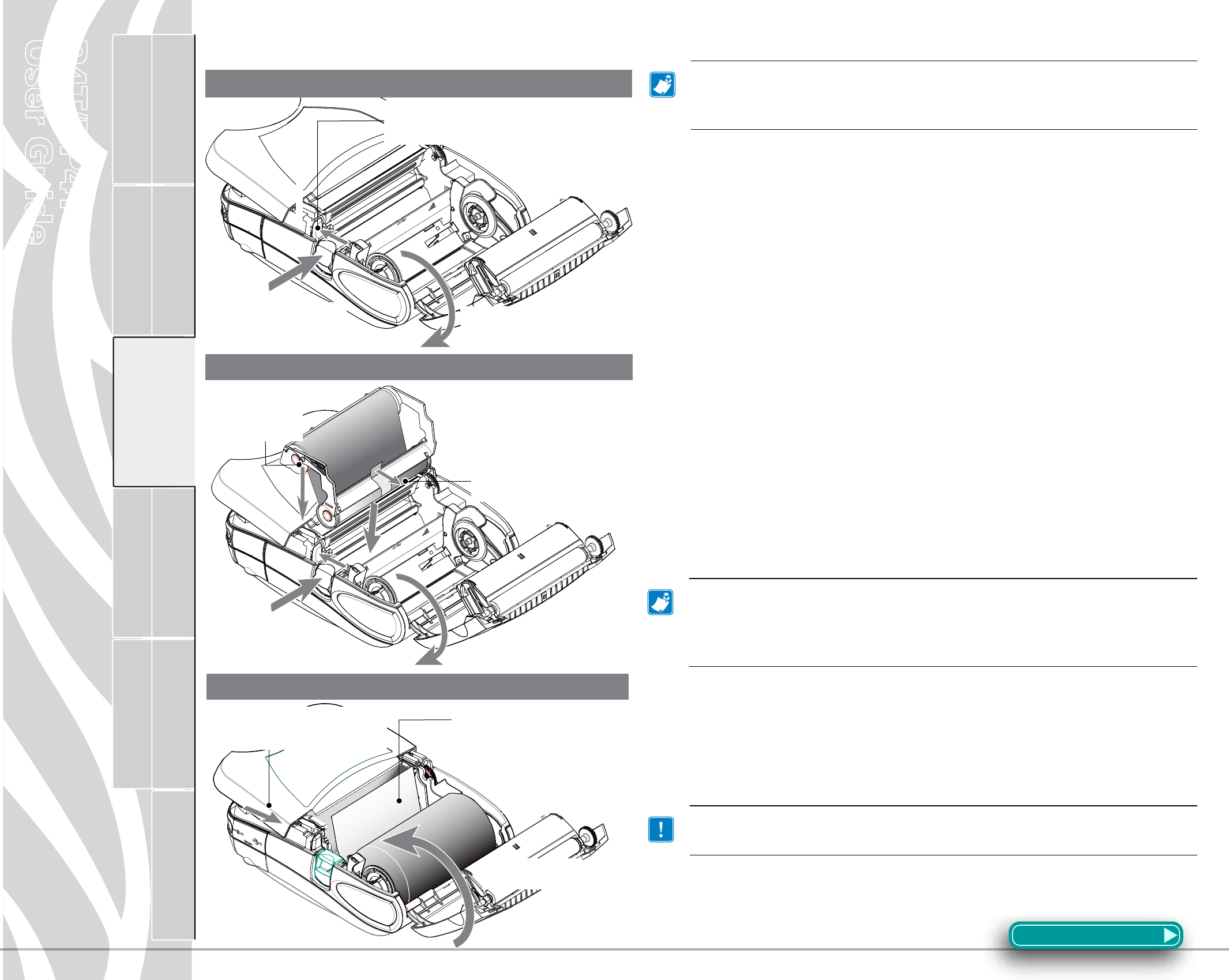
P4T/RP4T
User Guide
17
Printer Preparation Connecting the
Printer
Radio Regulatory
Information
RP4T Printers Maintenance Troubleshooting Specifications Appendices Index
P4T Overview
Manual
Introduction
Load the Ribbon Cartridge
Section Continues
IfyouareusingmediathatrequiresThermalTransfermedia,perform
thisstep.Ifyouareusingjournalstock,ormediathatusesdirect
thermaltechnologytoprintlabels,omitthisstep.
1. Open the Printer Covers
RefertoFigure9.1.
•Pressthelatchreleasebuttononthesideoftheprinterasshownat
“1”ingure9.1.Themediacoverwillopenautomatically
•Press on the Ribbon Cartridge Cover latch. The cover will slide
open.
2. Load the Ribbon Cartridge.
RefertoFigure9.2.
Select the correct Thermal Transfer cartridge for the media you will be us-
ing. Consult a Zebra sales representative for information regarding proper
media selection for your application.
•Removethetapeholdingthetransferribboninplace.
•Pre-tensionthetransferribbontoremovewrinklesbyturningthetake-
up roll until the media is stretched flat between the two rolls of the
Ribbon Cartridge cartridge.
•Droptheappropriatecartridgeinplace.Thelocatingpinsoneither
side of the cartridge must be secured in the printer frame.
The Ribbon Cartridges are protected by a security device which
veriescompatiblitywithP4TSeries printers. Use ofthirdparty
cartridgeswillcausetheprintertomalfunction,andwillvoidthe
factorywarranty.
Figure 9.1-Open the Printer Covers
3. Close the Printer Covers
RefertoFigure9.3.
•Ifyouhavenotdoneso,loadlabelmediaintotheprinterasdetailed
previously, ensuring that the media has been pulled out of the printer
past the printhead.
•SlidetheRibbonCartridgecovercloseduntilitlatchesinplace.
AlwaysclosetheRibbonCartridgecoverbeforeclosingthemedia
cover.
•Closethemediacoverandensureitlatchesinplace.
Figure 9.2-Load the Ribbon Cartridge
Figure 9.3-Close the Printer Covers
3. Close the
Media Cover
2. Drop the cartridge in place
over the printhead as shown.
1. Press down on the
Media Cover Latch Lever 2. Media cover
opens
1. Ensure Media is
pulled out of
Printer
3. Press the Ribbon
Cartridge Cover latch.
Cover will slide open
2. Slide the Ribbon Car-
tridge Cover closed until it
locks in place.
1. Remove tape and pre-tension
the media to remove wrinkles.
3. Locating pins
on the cartridge
must lock into the
printer frame.
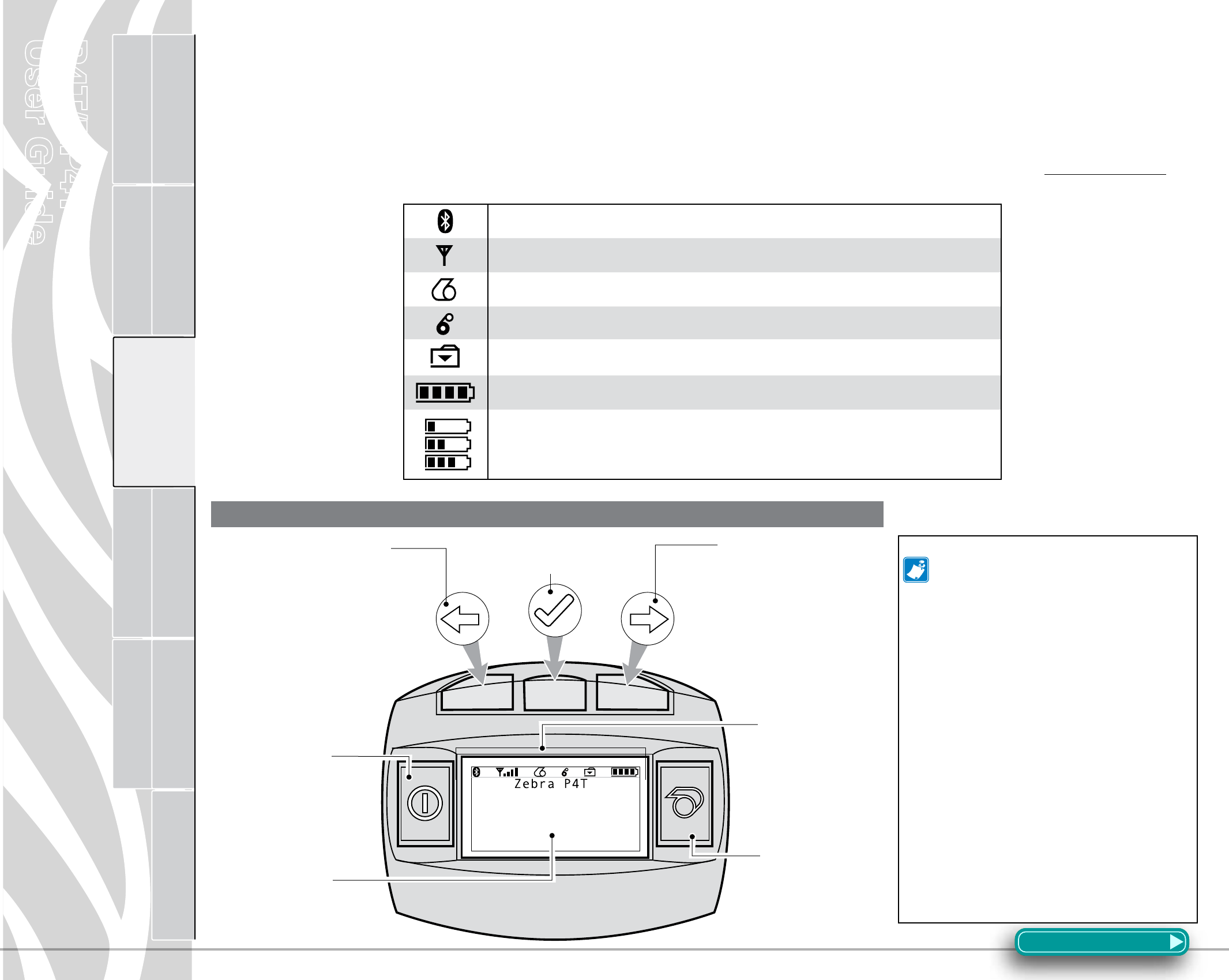
P4T/RP4T
User Guide
18
Printer Preparation Connecting the
Printer
Radio Regulatory
Information
RP4T Printers Maintenance Troubleshooting Specifications Appendices Index
P4T Overview
Manual
Introduction
Printer Controls
Operator Controls
The printer control panel has buttons for the power on/off and media feed functions and a display which provides information regard-
ing printer functions and application prompts. Two navigation keys provide easy selection of menu options.
The “Scroll Forward” button allows scrolling through the various options and settings. The “Scroll Back” button allows scrolling back
through previously viewed menus. Pressing the “Select” button selects the currently highlighted option or function.
The status icons at the top of the screen indicate the state of various printer functions per the table below. Refer to the Troubleshooting sec-
tion for more information on the printer status icons.
Indicates a Bluetooth connection is established. This icon is functional only on P4T Series printers with a
Bluetooth wireless option installed.
Indicates that the printer is associated with a wireless Local Area Network (LAN) using an 802.11b/g
compliant radio. This icon is functional only on a P4T Series printer with a WLAN wireless option installed.
A flashing icon indicates that the printer does not detect any label media. This could indicate an out of
media condition, or improperly loaded media.
A flashing icon indicates that the thermal transfer film is depleted.
A flashing icon indicates that data is being transferred to the printer.
A flashing outside element of the battery icon indicates low charge status. You should suspend any printing
operations and recharge or replace the Battery Pack as soon as is convenient.
Cycling charge level elements within the battery icon indicate the P4T Series battery is being charged by
the AC Adapter. Refer to Charger section of this manual.
Section Continues
If the printer displays:
“Please Recondition the Battery”
and beeps five times, the user
should recondition the battery to
return it to optimal operation.
To recondition the battery, charge
the battery fully overnight and then
use the printer until the printer
shuts down due to a low battery
condition.
Charge the battery again until it
is fully charged. At that point the
battery will be reconditioned. If the
battery is not reconditioned prop-
erly the indicated battery charge
level will indicate that there is more
charge remaining in the battery
pack than is actually available. Re-
conditioning performed as prompt-
ed by the printer will ensure accu-
rate capacity indication throughout
the serviceable life of the battery.
Figure 10 -P4T Series Printer Controls & LCD Icons
Scroll Forward Button
Press to scroll to the next
menu choice on the display.
Feed Button
Press to advance a
blank label or a pre-
determined length of
journal media.
Power Button
Press to turn unit on.
Press again to turn unit
off.
Scroll Back Button
Press to scroll to the previous
menu choice on the display.
.
Display
Indicates status mes-
sages and menu
prompts..
Printer Status
Icons
Refer to the Trouble-
shooting section for
more information on
the status icons.
Select Button
Press to select a menu choice on
the display.
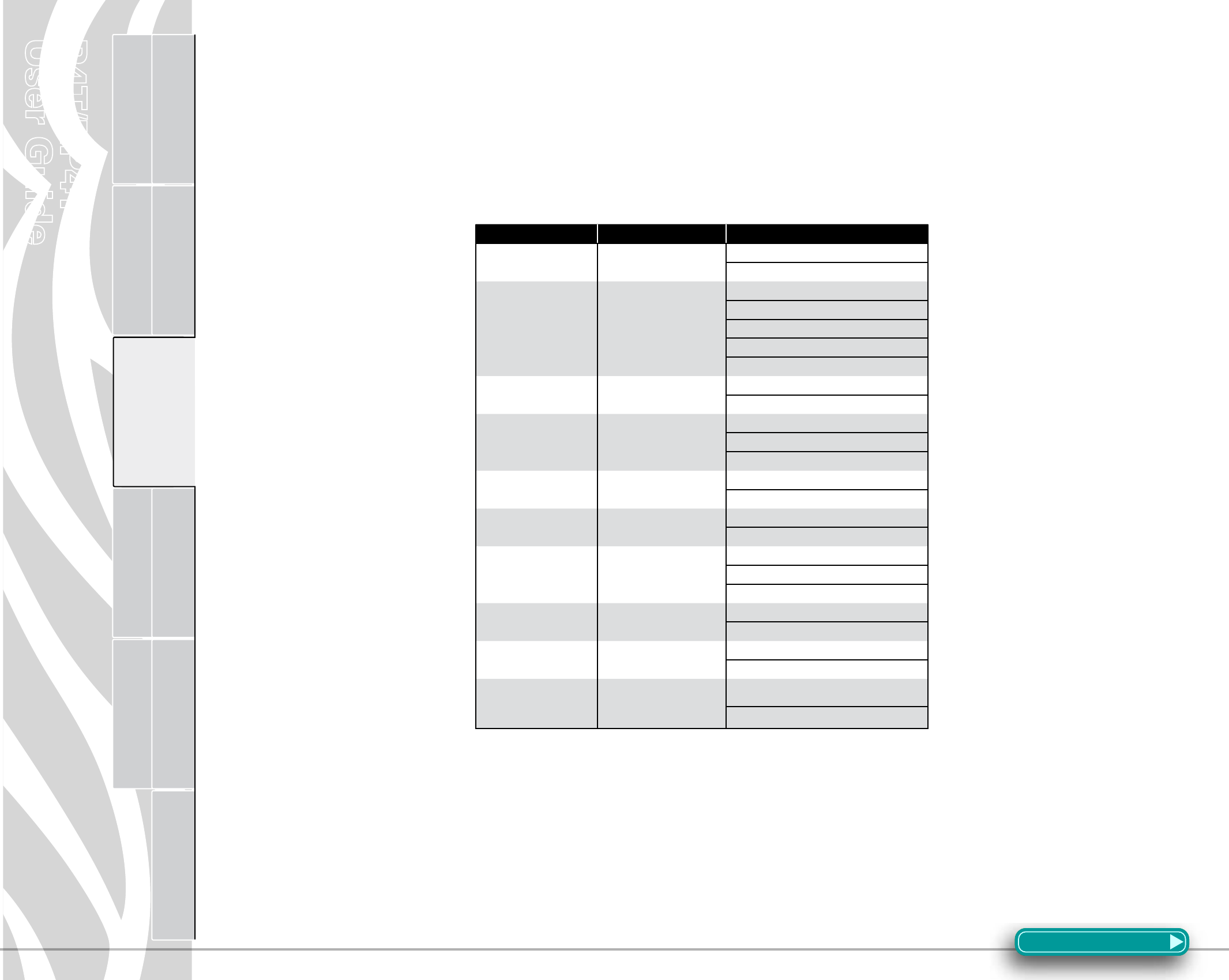
P4T/RP4T
User Guide
19
Printer Preparation Connecting the
Printer
Radio Regulatory
Information
RP4T Printers Maintenance Troubleshooting Specifications Appendices Index
P4T Overview
Manual
Introduction
Programmable LCD Settings
Inadditiontothestatusicons,theLCDonthecontrolpanelcandisplaymanyoftheprinter’ssettingsandfunctionsastextasdeter-
mined by the printer’s application. Applications can be written to allow the user to view and /or modify these settings using the scroll
andselectkeysonthedisplay.Refertothefollowingtablesforapartialsetofprinterfeaturesthatcanbeprogrammedtodisplayon
theLCD.
TheLCDhasabacklightingoptionwhichallowsviewingofthescreeninadarkenvironment,orprovidesbettercontrastinaverybright
environment.Useofthedisplaybacklightwilldecreasethetimetheprinterwillrunbetweencharges.Refertothesection“Extending
BatteryLife”formoreinformation.
Extended LCD Functions
Function Default setting Scroll & Select Options
Sensor Type Bar • Bar
• Gap
Baud Rate 19200
• 9600
• 19200
• 32400
• 57600
• 115200
Data Bits 8 • 7
• 8
Parity N (none)
• E (Even)
• N (None)
• O (Odd)
LCD Contrast 8 • Increase (15max.)
• Decrease (15 max.)
No-activity Timeout 120 sec. • Decrease (0 min.)2
• Increase (120 max.)
Audio Volume 3
• 1 – Low
• 2 – Medium
• 3 - High
Media Type Journal • Journal
• Label
LCD Backlight3Momentary On • Momentary On w/ time delay
• Off
Factory Reset (Resets
all to factory set
values)
No • No
• Yes
NOTES:
1: LCD menu options are under specific application control. Not all options may be available In your printer’s application.
2: A No-activity timeout value of “0” means the printer will remain on until powered off by the operator.
3: LCD Backlight turns on when any key other than FEED is pressed.
Section Continues
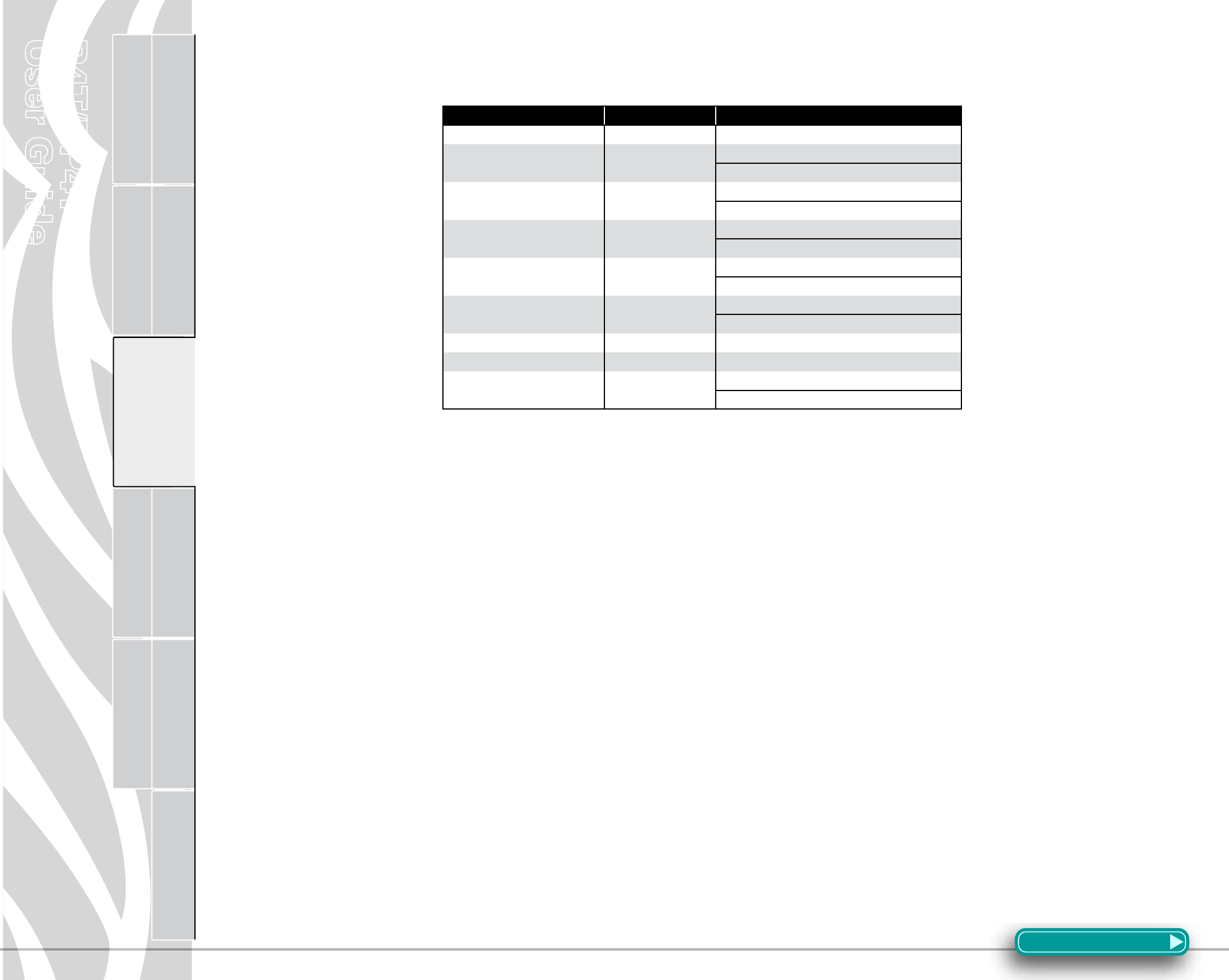
P4T/RP4T
User Guide
20
Printer Preparation Connecting the
Printer
Radio Regulatory
Information
RP4T Printers Maintenance Troubleshooting Specifications Appendices Index
P4T Overview
Manual
Introduction
Display Functions Not Controlled from the Keypad
WhiletheparametersinthistablecanappearonthedisplaytheycanbesetonlybyusingaPCrunningZebra’sLabelVistalabelcre-
ationprogramandadatacablelinktotheprinter.
Function Default setting Scroll & Select Options
WLAN ID Factory Set Value N/A
Tear-off Position (Top of Form) 00 • Increase (max. = +10)
• Decrease (min. = -120)
Network & RF Settings • All protocols On
• Protocols On or Off individually
Bridge Mode Off • Off
• On
DTR/VBUS-Power Off Off • On
• Off
Present-at 000 • Increase (max.= +120)
• Decrease (min. = 000
Bluetooth parameters n/a Displays current Bluetooth operating parameters
802.11g operating parameters n/a Displays current 802.11g WLAN parameters
Media Type Journal •Journal
•Label
Section Continues
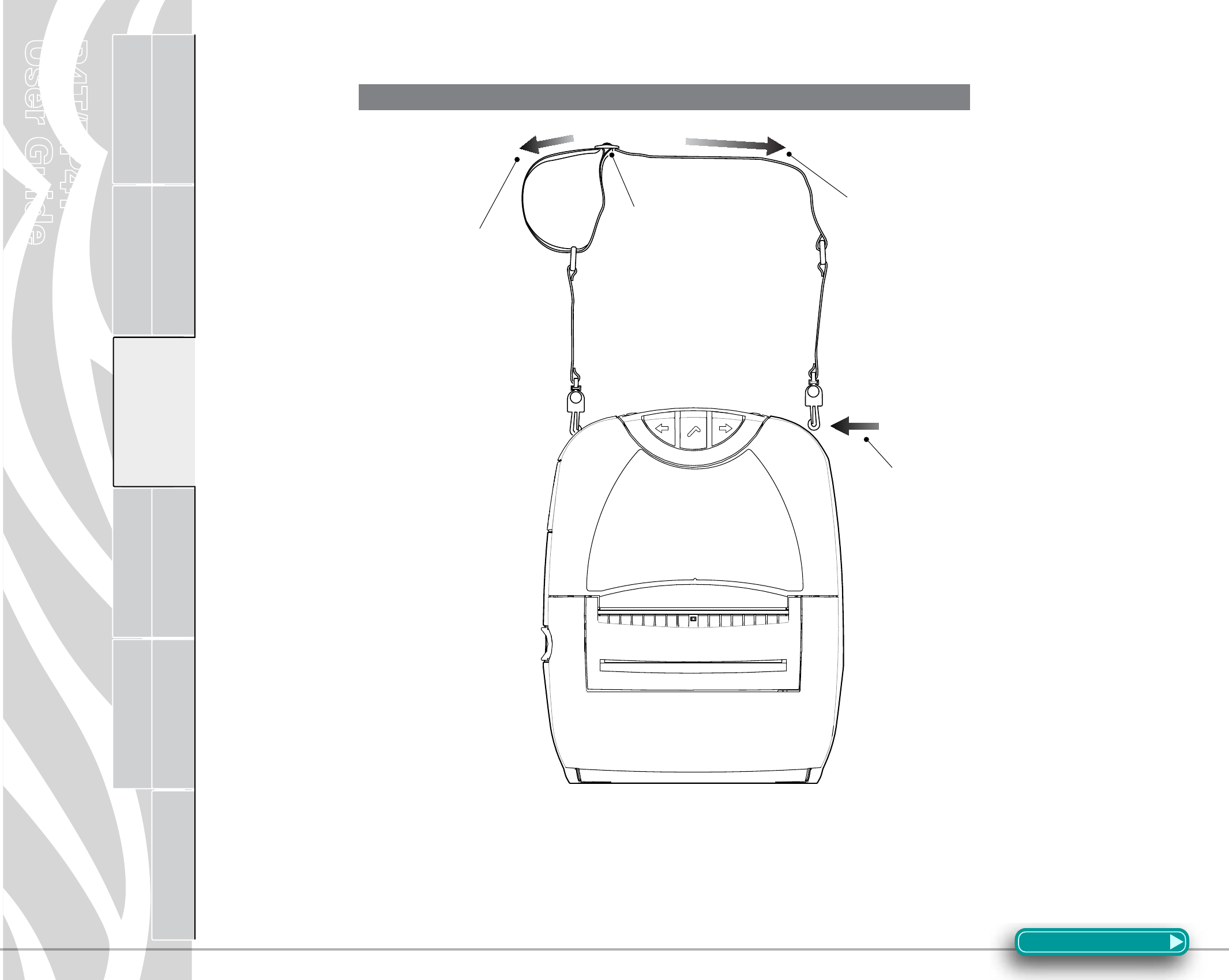
P4T/RP4T
User Guide
21
Printer Preparation Connecting the
Printer
Radio Regulatory
Information
RP4T Printers Maintenance Troubleshooting Specifications Appendices Index
P4T Overview
Manual
Introduction
Adjustable Shoulder Strap
Refertogureabove.Snapeachendoftheshoulderstrapintotheretainingfeaturesontopoftheprinter.Holdthebuckleandadjust
the strap as shown until you achieve the desired length.
Figure 11- Shoulder Strap
Section Continues
Hold Buckle
Pull Strap here
to lengthen
Pull Strap here
to shorten
Snap into feature on
printer
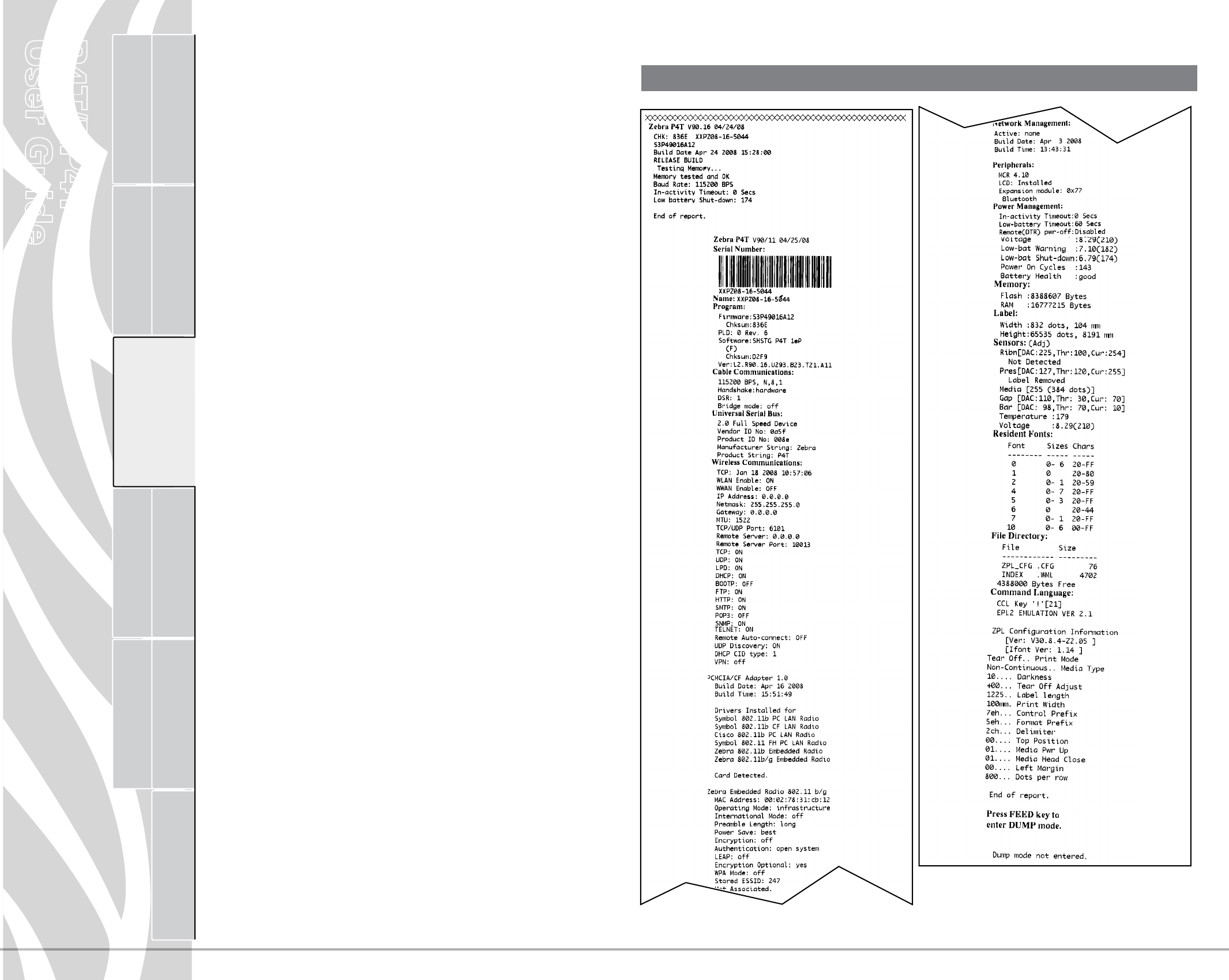
P4T/RP4T
User Guide
22
Printer Preparation Connecting the
Printer
Radio Regulatory
Information
RP4T Printers Maintenance Troubleshooting Specifications Appendices Index
P4T Overview
Manual
Introduction
Verify the Printer Is Working
Before you connect the printer to your computer or
portabledataterminal,makesurethattheprinterisin
properworkingorder.Youcandothisbyprintingacon-
gurationlabelusingthe“twokeyreset”method.Ifyou
can’t get this label to print, refer to the “Troubleshooting”
section of this manual
Printing a Configuration Label
1.Turntheprinteroff.Loadthemediacompartment
withjournalmedia(mediawithnoblackbarsprinted
ontheback)
2.PressandholdtheFeedButton.
3.PressandreleasethePowerbuttonandkeepthe
Feed button pressed. When printing starts, release
the Feed button.
Theunitwillprintalineofinterlocking“x”characters
toensureallelementsoftheprintheadareworking,print
out the version of software loaded in the printer and then
print two reports.
The first report indicates the printer model, ROM ver-
sion, serial number, baud rate, etc. The second report
prints out more detailed information on the printer’s con-
figuration and parameter settings. If no second report
appears, there is no application loaded.
See the Troubleshooting Section for a further discussion
on how to interpret the configuration label as a diagnostic
tool.
Figure 12 -Sample P4T Series Configuration Label
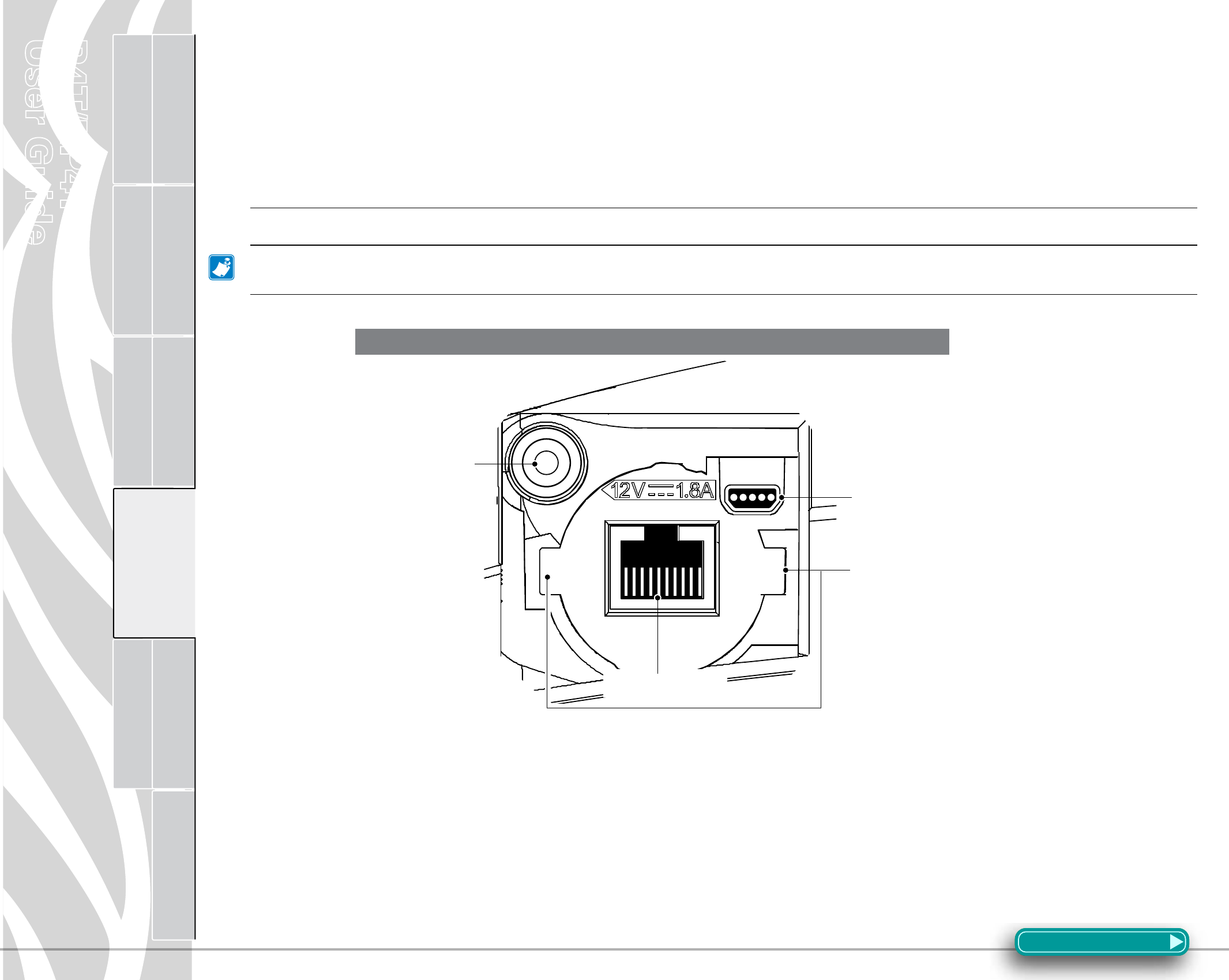
P4T/RP4T
User Guide
23
Printer Preparation Connecting the
Printer
Radio Regulatory
Information
RP4T Printers Maintenance Troubleshooting Specifications Appendices Index
P4T Overview
Manual
Introduction
Connecting the Printer
The printer must establish communications with a host device which sends the data to be printed. Communications occur in three
basic ways:
• ByacablebetweentheprinteranditshostterminalusingeitherRS232CorUSBprotocols
• BymeansofaBluetoothshort-rangeradiofrequencylink
• BymeansofawirelessLAN(LocalAreaNetwork)per802.11b/gspecications
Cable Communications
Caution•Theprintershouldbeturnedoffbeforeconnectingordisconnectinganycommunicationscable.
Note•AllP4Tseriesprinterscancommunicatebycable;thespeciccableusedwithyourprintercanvarywiththehost
terminal.
Serial (RS232C) or USB Port
The10-pinmodularconnectoronyourcommunicationscableplugsintothecombinationRS232C/USBcommunicationsportonthe
side of the printer. Signals and pin assignments for both communications ports are in the Specifications section of this manual.
The protocol used with this port is determined by the communications cable you are using. Refer to Appendix A for more information
onthecommunicationscablesofferedwiththeP4TSeries.
PlugtheconnectorintotheRS232portandensureitslockingdevicehasclickedintoposition.
TheotherendofthecablemustbepluggedintothehostterminalasshowninFigure14,ortoaserialportonacomputerasshown
inFigure15.
Figure 13: P4T Series Communication Ports
Section Continues
RS232/USB Port
USB Port
Battery Charging
Receptacle
Align Locking Plug
features with these
cutouts.
Rotate clockwise
to lock the cable
in place; counter-
clockwise to un-
lock the cable.
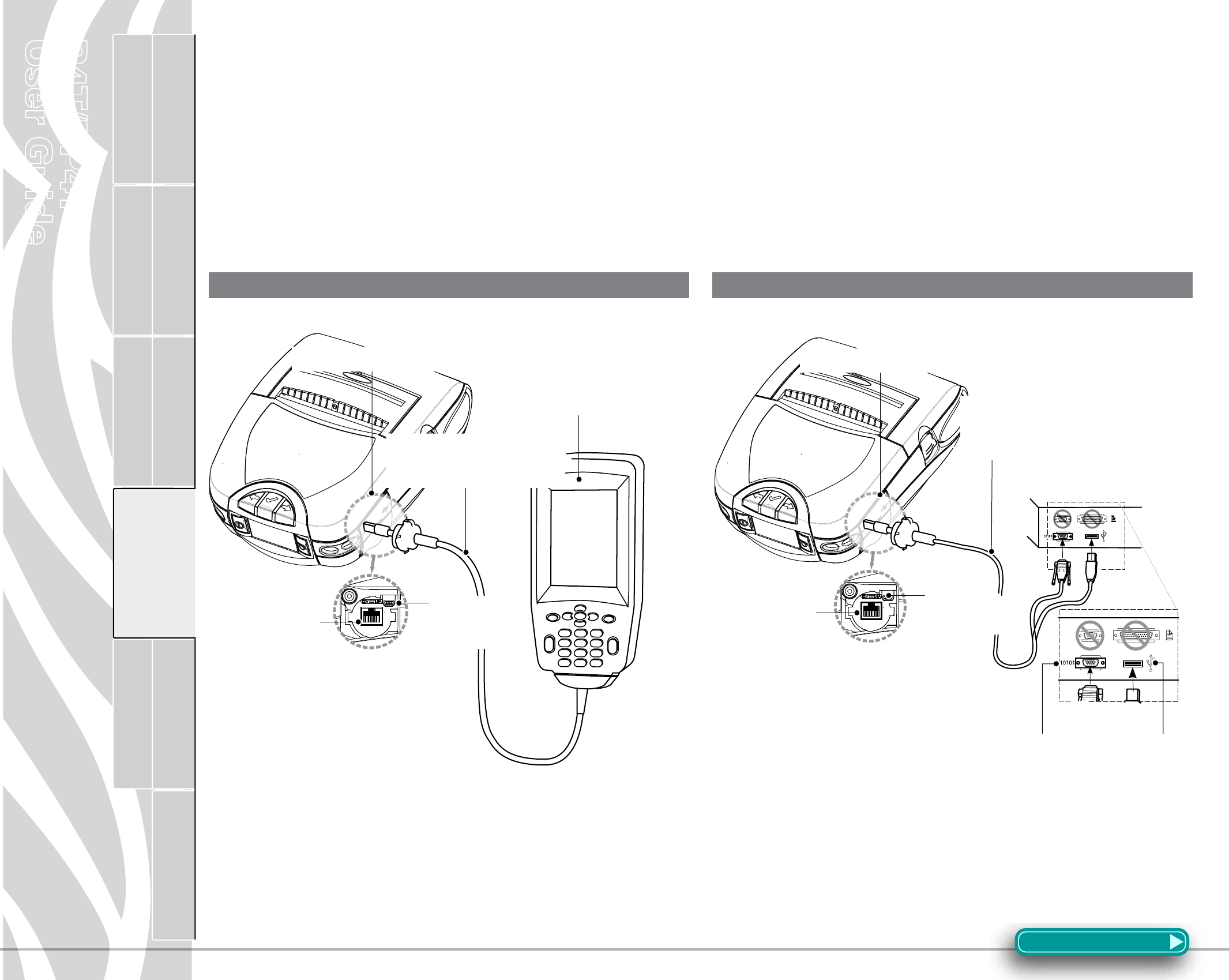
P4T/RP4T
User Guide
24
Printer Preparation Connecting the
Printer
Radio Regulatory
Information
RP4T Printers Maintenance Troubleshooting Specifications Appendices Index
P4T Overview
Manual
Introduction
USB
P4TSeriesPrintersalsohaveaUSBtypeBportlocateddirectlyaboveandtotherightoftheRS232Cport.(RefertoFigure13)
The USB port is configured with the USB Open HCI interface driver allowing it to communicate with Windows® based devices. USB
driversareincludedintheZebraUniversalDriverwhichcanbedownloadedfromwww.zebra.com.Otherterminalsorcommunications
devices may require the installation of special drivers to use the USB connection. Consult your Zebra re-seller or the factory for further
details.
Section Continues
Figure 14- Connecting to a Terminal Figure 15- Connecting to a PC
RS232C or USB
Communications Cable
to Terminal
Terminal
RS232
Connector
USB
Connector
Communications Ports
RS-232C or USB
Communications Cable to
Computer
Refer to Appendix A for part numbers.
USB
Connector
RS232
Connector
Communications Ports
RS232
Connector
USB
Connector
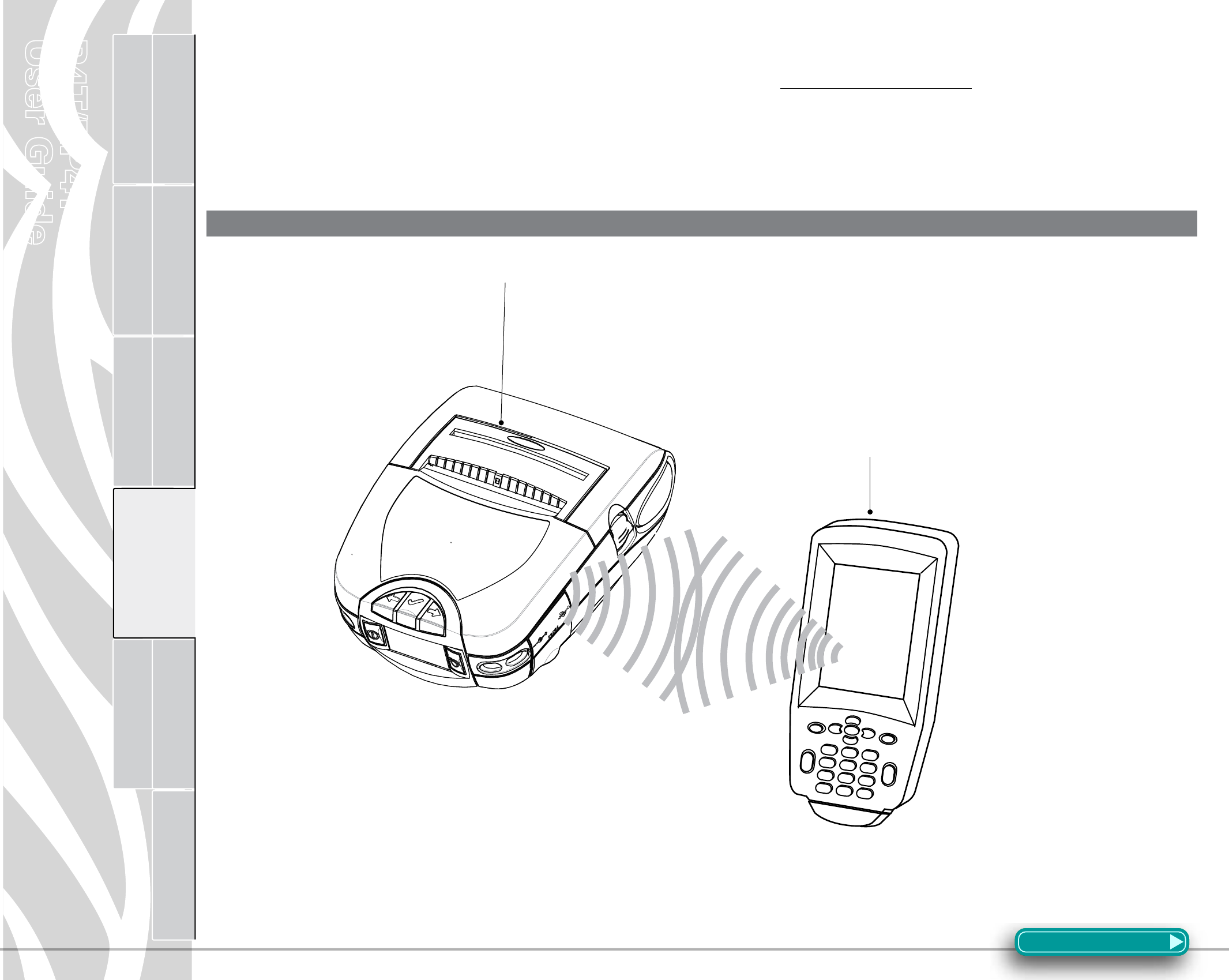
P4T/RP4T
User Guide
25
Printer Preparation Connecting the
Printer
Radio Regulatory
Information
RP4T Printers Maintenance Troubleshooting Specifications Appendices Index
P4T Overview
Manual
Introduction
Connect the Printer by Radio
IfyourP4TSeriesprinterhasaradiooption,youcanconnectwirelesslytoeitheraterminalorawirelessnetwork(WLAN.)Refertothe
MobilePrinterWirelessCongurationGuideavailableontheproductCDoratwww.zebra.com/manuals for help on setting up wireless
communications with your printer.
Figure 16- Connecting Wirelessly to a Terminal
Section Continues
P4T Series printer with
Wireless option
Terminal with wireless
communications
capability
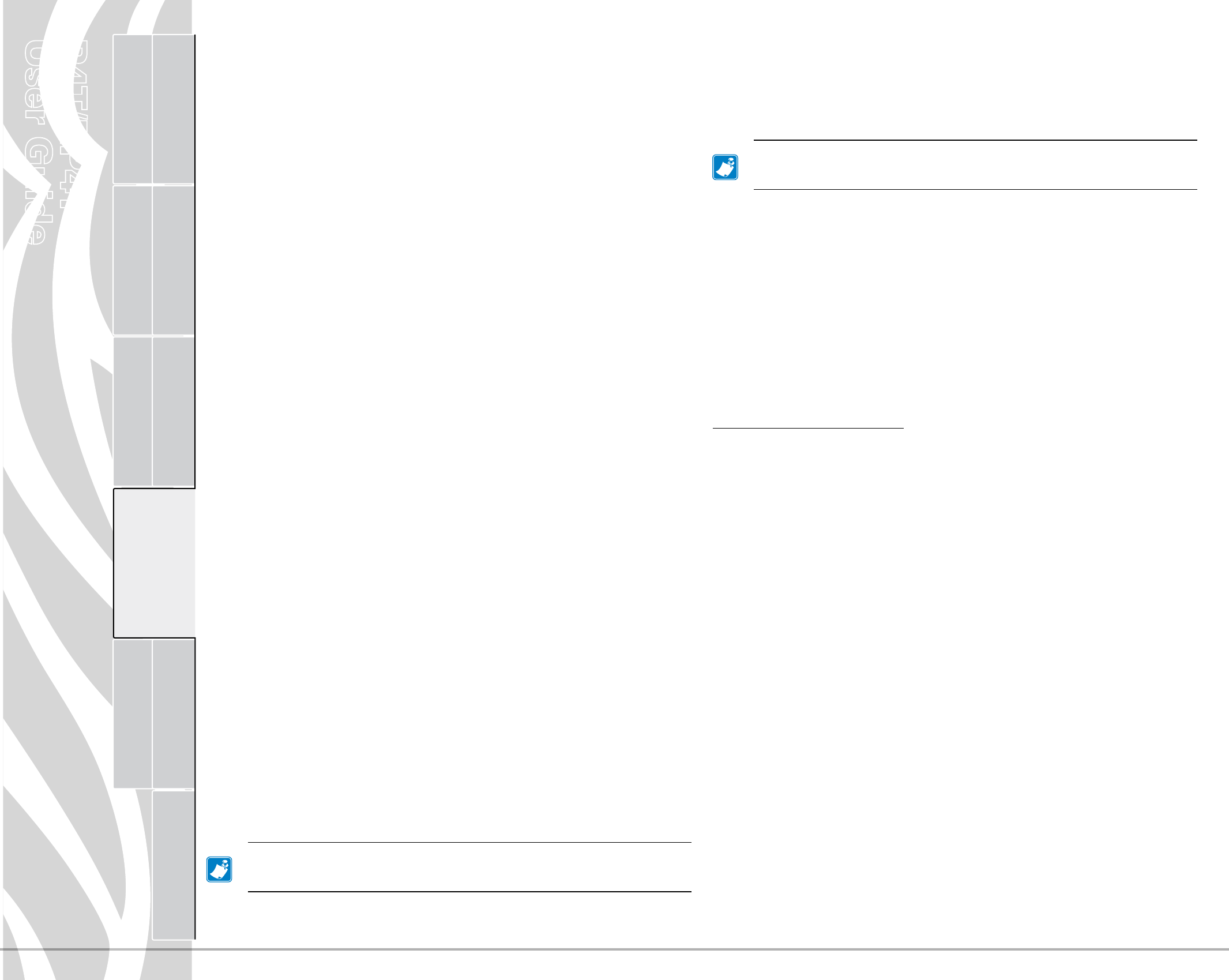
P4T/RP4T
User Guide
26
Printer Preparation Connecting the
Printer
Radio Regulatory
Information
RP4T Printers Maintenance Troubleshooting Specifications Appendices Index
P4T Overview
Manual
Introduction
Wireless Communications
Wireless Communications with Bluetooth®
“Bluetooth” is a worldwide standard for the exchange of data
between two devices via radio frequencies. Bluetooth radios are
relatively low powered to help prevent interference with other de-
vices running at similar radio frequencies. This limits the range of
aBluetoothdevicetoabout10meters(about32feet).
Both the printer and the device it communicates with must follow
the Bluetooth standard.
BluetoothNetworkingOverview
EachBluetoothenabledP4TseriesprinterhasauniqueBluetooth
DeviceAddress(BDA)loadedintoitsradiomodulewhenmanu-
factured.
Bluetoothsoftwareisalwaysrunninginthebackground,readyto
respondtoconnectionrequests.Onedevice(knownasthemaster
ortheclient)mustrequestaconnectionwithanother.Thesecond
device(theslaveortheserver)thenacceptsorrejectstheconnec-
tion.ABluetoothenabledP4Tseriesprinterwillnormallyactas
aslavecreatingaminiaturenetworkwiththeterminalsometimes
referred to as a “piconet.”
For the most part, communications using Bluetooth are initiated
and processed without any operator intervention.
P4TSeriesprinterscanbeequippedwithbothaBluetoothand
an802.11b/gradio,allowingcommunicationswithbothBluetooth
enableddevicesandaWirelessLocalAreaNetwork(WLAN)(see
discussionbelow).
Wireless Local Area Network Overview
P4TSeriesprinterscanbeequippedwithseveralradiooptions
whichusetheindustrystandard802.11borgWLANprotocols.
• P4TSeriesWirelessNetworkPrinterswiththeZebra802.11b/g
WLAN radio module can be identied by the Product Con-
gurationCode(PCC)ontheserialnumberlabelontheback
of the printer. Printers with this option will have a “K” as the
seventh character of the PCC Code. Printers with this option
mayalsobeidentiedbytheFCCID:TBDon printers built for
the North American region.
• P4T printers with both an 802.11b/g WLAN radio and a
Bluetooth radio running in the same unit are considered to be
dual radio devices. Printers with this option will have an “A”
as the seventh character of the PCC Code.
RP4Tmodelprinterscannotbeconguredwiththe802.11g/
Bluetoothdualradiooption.
DualradioequippedP4TunitswillhaveaBluetoothradioFCC
ID“T.B.D.”and802.11bCompactashradioFCCID“T.B.D.”.
TheFCCIDnumbersandotherregulatoryinformationforboth
radios are also located on the serial number label of printers
built for the North American region.
RefertoAppendixDofthismanualformoreinformationon
locatingtheProductCongurationCode.
Printersequippedwitheitherofthe802.11b/gradiooptionsallow
wirelesscommunicationasanodewithinaWLANanditswireless
capabilitiesallowcommunicationsfromanypointwithintheWLAN’s
perimeter.P4TprintersequippedwiththedualBluetooth/802.11b/g
WLANradiocongurationcanbe linkedtoboth aWLANanda
Bluetoothnetworksimultaneously.
Methods of establishing communications to P4T Series print-
erswillvarywitheachLANapplication.Generalinformationon
establishing WLAN communications can be found in either the
”CPCLProgrammersManual”orthe“QuickStartGuideforMobile
Wireless Printers” both available on-line at the Zebra Web site
www.zebra.com/manuals.MoreinformationandLANcongura-
tionutilitiesmayalsobefoundinZebra’sLabelVista™program
(version2.8andlater).ThelatestversionofLabelVistamaybe
downloaded from Zebra’s Web site.
Setting Up the Software
P4T Series printers use Zebra’s CPCL Programming language
whichwasdesignedformobileprintingapplications.CPCLisfully
described in the ”CPCLProgrammersManual”,availableon-line
at the Zebra Web site.
You can also use LabelVista™,Zebra’sWindowsbasedlabelcre-
ation program which uses a graphical interface to create and edit
labelsintheCPCLlanguage.
AllP4TSeriesprinterssupportaninterpreterfortheZPLIIpro-
gramminglanguage.RP4Tprinters(withRFIDencoding/reading
capabilities)usetheZPLprogramminglanguage’sextensivesetof
RFIDcommands.
IfyouplantouseZPLII,refertotheappropriateProgramming
Guides available on-line from Zebra’s Web site.
If you have a printer with wireless capabilities, you can refer to
the “Wireless Configuration Guide.” also available on the Zebra
web site.
If you choose to use a third party label preparation system, follow
theinstallationinstructionsincludedinthepackage.
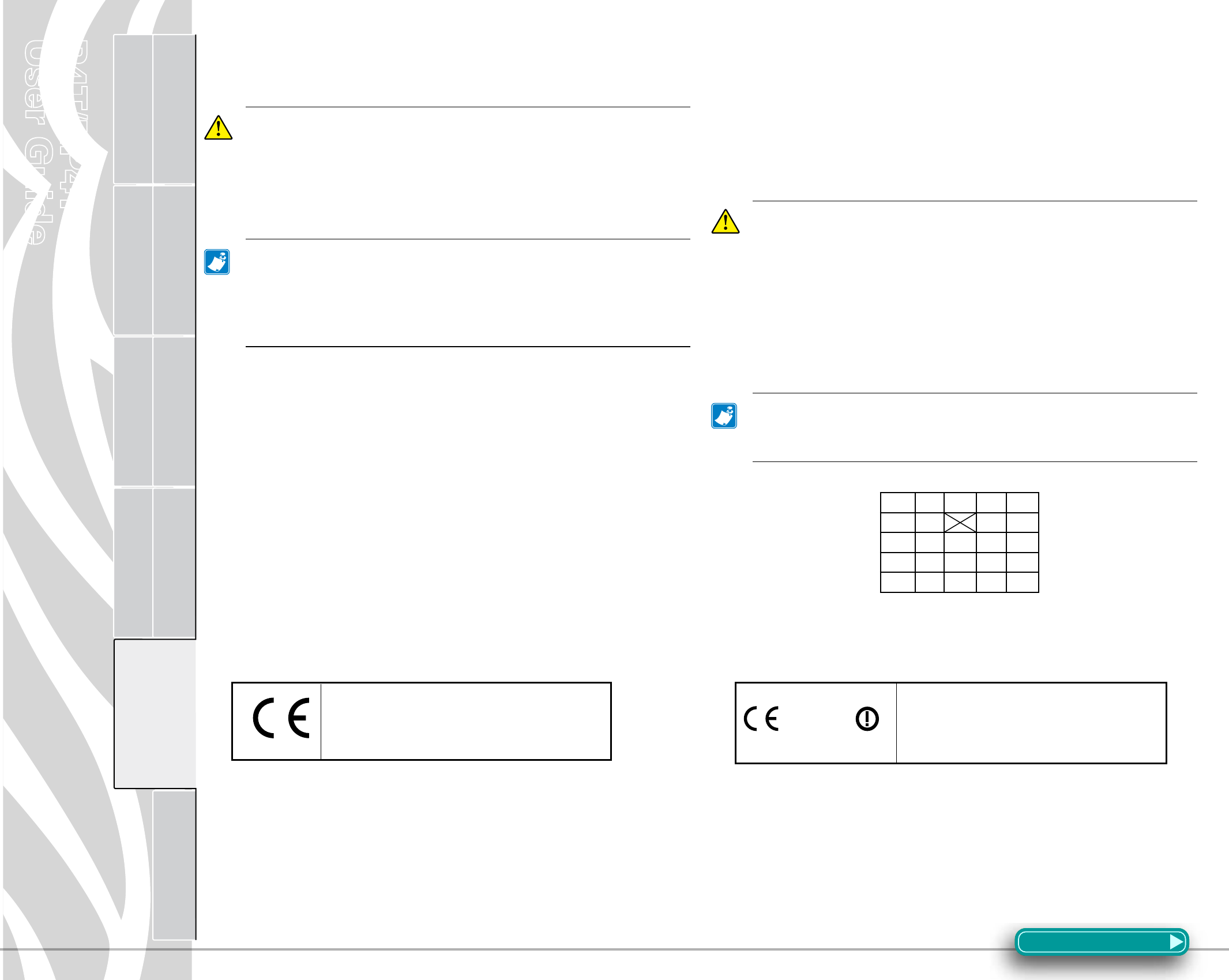
P4T/RP4T
User Guide
27
Printer Preparation Connecting the
Printer
Radio Regulatory
Information
RP4T Printers Maintenance Troubleshooting Specifications Appendices Index
P4T Overview
Manual
Introduction
Bluetooth ZBR4 Radio
Caution • ExposuretoRadioFrequencyRadiation.
TheradiatedoutputpowerofthisinternalBluetoothradio
isfarbelowtheFCCradiofrequencyexposurelimits.The
internalBluetoothradiooperateswithinguidelinesfound
inradiofrequencysafetystandardsandrecommendations.
Donotusetheprinterinanunauthorizedmanner.
Note • The following section only applies when the
TBD-ZBR4BluetoothRadio(TBD)isinstalledinaP4TSeries
printer. Unless specied elsewhere in this manual, the
antennausedforthistransmittermustnotbeco-locatedor
mustnotoperateinconjunctionwithanyotherantenna.
EuropeanRegulatoryInformationfortheTBD-ZBR4BluetoothRadio
This device is intended for use in all EU and EFTA member states.
Europe–EUDeclarationofConformity
ThisdevicecomplieswiththeessentialrequirementsoftheR&TTEDirective
1999/5/EC.Thefollowingtestmethodshavebeenappliedinordertoprove
presumptionofcompliancewiththeR&TTEDirective1999/5/EC:
•EN60950:2000SafetyofInformationTechnologyEquipment
•EN300328-2V1.4.1(2003-04)Technicalrequirementsforspread-spectrum
radio equipment
•EN301489-1/-17V1.4.1/1.2.1(2002-08)EMCrequirementsforspread-
spectrum radio equipment.
Thisdeviceisa2.4GHzwirelessLANtransceiver,intendedforindoorhomeand
office use in all EU and EFTA member states.
WLAN Module Using 802.11b/g Radio
The following section only applies when the 802.11b/g WLAN module (FCC ID: TBD) is
installed in a P4T Series printer). Other than conditions specified elsewhere in this manual,
only one of the radio options can be installed in the printer at one time and the antenna
used for these transmitters must not be co-located or must not operate in conjunction
with any other antenna.
P4T Series models have the FCC ID number on a label on the back of the unit.
Caution•UseofaP4TSeriesprinterwiththeradiomodule
markedwithFCCID:TBDmeetstheFCCrequirementsfor
radio frequency (RF) radiation exposure in the standard
bodyworncongurationwithnominimumseparation.In
thisconguration,whichapplieswhetherthebeltclipor
shoulderstrapisused,thefaceoftheprinterfromwhich
paperistransportedisfacingawayfromtheuser’sbody.
Thestandardcongurationmustalwaysbeusedwhenthe
printerisbodyworn.
The P4T Series printer with this radio option has been
SAR tested. The maximum SAR value measured is:
TBDW/Kg(1gaverage
EuropeanRegulatoryInformationforthisRadio
AT BE CY CZ DK
EE FI FR DE GR
HU IE IT LV LT
LU MT NL PL PT
SK SI ES SE GB
Note: -Member states in the EU with restrictive use for this device are
crossed out!
ThisdeviceisalsoauthorizedforuseinallEFTAmemberstates(CH, IS, LI, NO)
Important Notice:
This device is a portable RF printer intended
for commercial and industrial use in all EU
and EFTA member states.
0336
Important Notice:
This device is a portable RF printer
intended for commercial and industrial use
in all EU and EFTA member states except in
France where restrictive use applies
Radio Regulatory Information
Section Continues
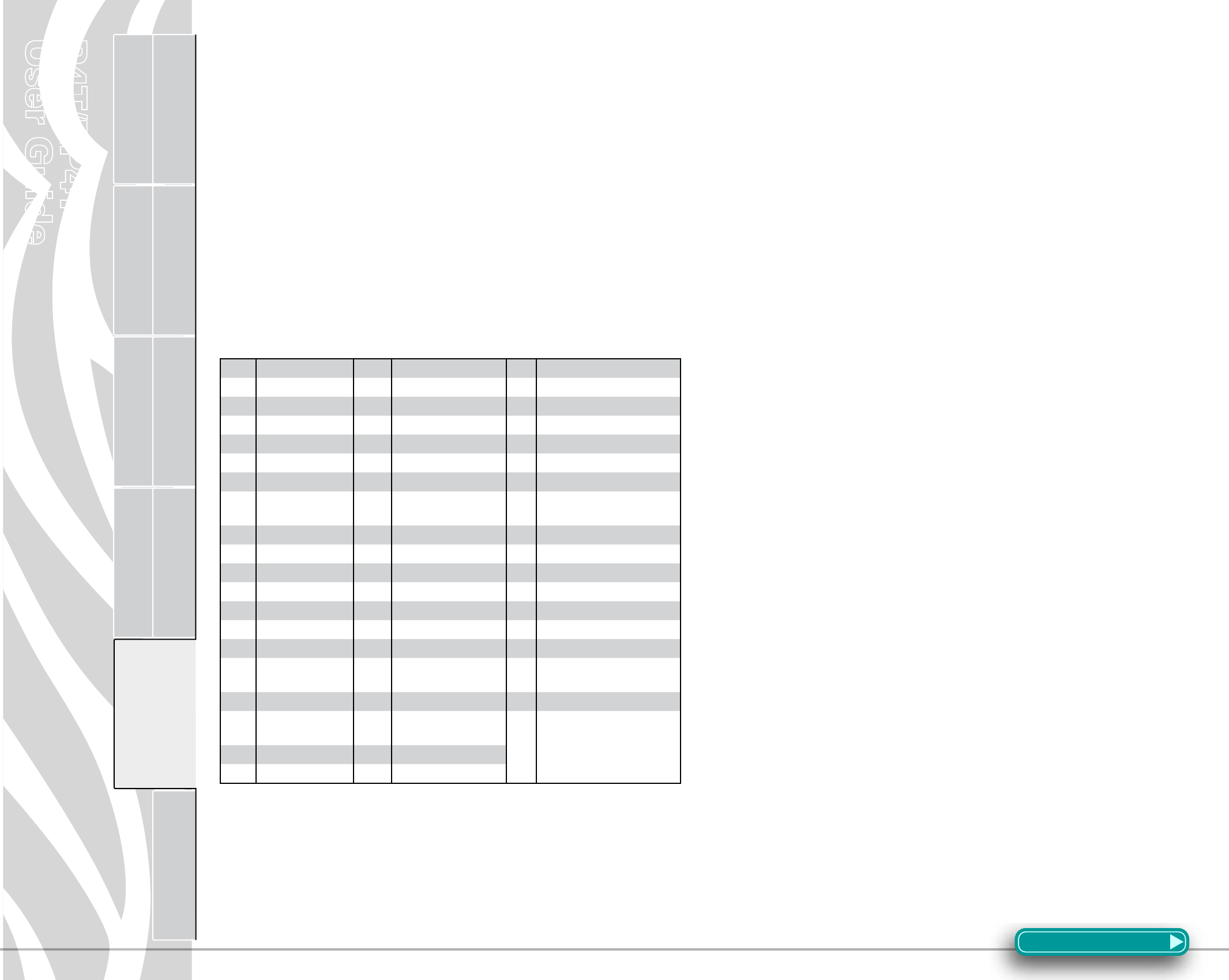
P4T/RP4T
User Guide
28
Printer Preparation Connecting the
Printer
Radio Regulatory
Information
RP4T Printers Maintenance Troubleshooting Specifications Appendices Index
P4T Overview
Manual
Introduction
Europe–EUDeclarationofConformity
ThisdevicecomplieswiththeessentialrequirementsoftheR&TTEDirective
1999/5/EC.Thefollowingtestmethodshavebeenappliedinordertoprove
presumptionofcompliancewiththeR&TTEDirective1999/5/EC:
•EN55022:1998
European Emissions Standard
•EN60950:2000
Safety of Information Technology Equipment
•EN300328-2V1.2.1(2001-12)
Technical requirements for spread-spectrum radio equipment
•EN301489-17V1.2.1(2002-08)
EMC requirements for spread-spectrum radio equipment.
Thisdeviceisa2.4GHzwirelessLANtransceiver,intendedforindoorhomeand
office use in all EU and EFTA member states, except in France where restrictive
use applies.
The use of this frequency band in France is subject to restrictions. You may only
usechannels10and11(2457and2462MHz)onFrenchterritory,exceptinthose
Frenchdepartmentsaslistedinthetablebelowwherechannels1-13(2412-
2472MHz)maybeused.Formoreinformationseehttp://www.anfr.fr/and/or
http://www.art-telecom.fr
01 Ain 36 Indre 69 Rhone
02 Aisne 37 IndreetLoire 70 Haute Saone
03 Allier 39 Jura 71 SaoneetLoire
05 Hautes Alpes 41 LoiretCher 72 Sarthe
08 Ardennes 42 Loire 75 Paris
09 Ariege 45 Loiret 77 Seine et Marne
10 Aube 50 Manche 78 Yvelines
11 Aude 54 Meurthe et
Moselle 79 DeuxSievres
12 Aveyron 55 Meuse 82 Tarn et Garonne
16 Charente 57 Moselle 84 Vaucluse
19 Correze 58 Nievre 86 Vienne
2A Corse Sud 59 Nord 88 Vosges
2B Haute Corse 60 Oise 89 Yonne
21 Cote d’Or 61 Orne 90 Territoire de Belfort
24 Dordogne 63 PuydeDome 91 Essonne
25 Doubs 64 Pyrenees
Atlantique 92 Hauts de Seine
26 Drome 65 Hautes Pyrenees 93 SeineStDenis
27 Eure 66 Pyrenees
Orientales 94 ValdeMarne
32 Gers 67 Bas Rhin
35 IlleetVilaine 68 Haute Rhin
RepublicofChinaRegulatoryInformationforthe802.11b/gRadio
經型式認證合格之低功率射頻電機,非經許可,公司、商號或使用
者均不得擅自變更頻率、加大功率或變更原設計之特性及功能。
低功率射頻電機之使用不得影響飛航安全及干擾合法通信;經發
現有干擾現象時,應立即停用,並改善至無干擾時方得繼續使用。
前項合法通信,指依電信法規定作業之無線電通信。低功率射頻
電機須忍受合法通信或工業、科學及醫療用電波輻射性電機設備
之干 擾。
Accordingto“AdministrativeRegulationsonLowPowerRadioWavesRadiated
Devices”WithoutpermissiongrantedbytheDGT,anycompany,enterprise,or
user is not allowed to change frequency, enhance transmitting power or alter
original characteristic as well as performance to a approved low power radio-
frequency devices. The low power radio-frequency devices shall not influence
aircraft security and interfere legal communications; If found, the user shall
cease operating immediately until no interference is achieved. The said legal
communications means radio communications is operated in compliance with
the Telecommunications Act.
The low power radio-frequency devices must be susceptible with the
interference from legal communications or ISM radio wave radiated devices.
Section Continues
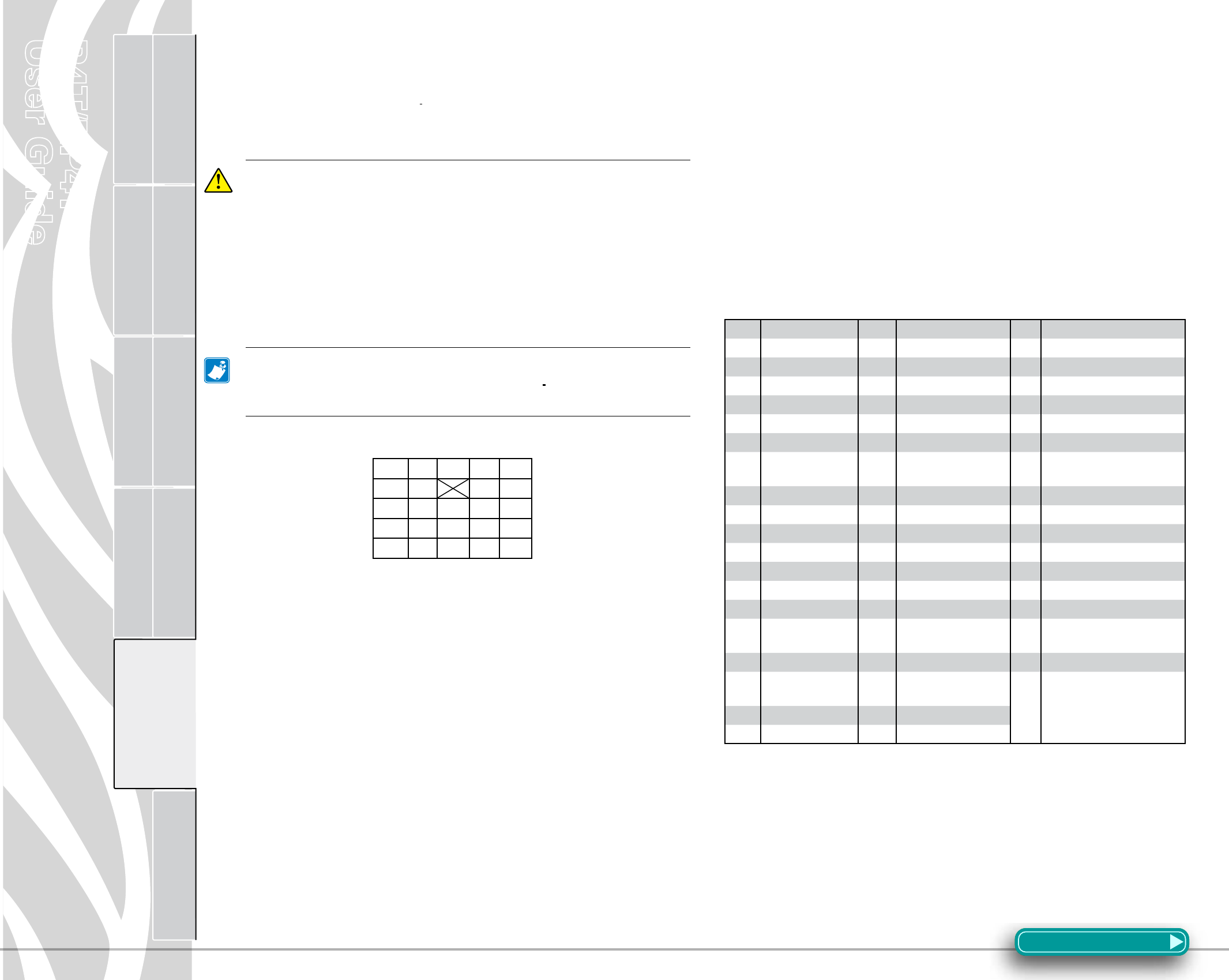
P4T/RP4T
User Guide
29
Printer Preparation Connecting the
Printer
Radio Regulatory
Information
RP4T Printers Maintenance Troubleshooting Specifications Appendices Index
P4T Overview
Manual
Introduction
802.11b/g and Bluetooth Co-located Radio
Modules
The following section only applies when the CF (Compact Flash) WLAN module (With FCC
ID:TBD) and Bluetooth module (FCC ID:TBD) are installed in a P4T printer. This co-
located radio configuration has demonstrated compliance to FCC regulations. The FCC
ID numbers are on the serial number label on the back of the printer and can be read with
the module installed.
Caution • Use of a P4T printer with the radio module
markedwithboth“FCCID:TBD”and“TBD”meetstheFCC
requirements for radio frequency (RF) radiation exposure
inthestandardbodyworncongurationwithnominimum
separation.Inthisconguration,whichapplieswhetherthe
beltcliporshoulderstrapisused,thefaceoftheprinter
fromwhich paper istransportedisfacingawayfromthe
user’s body. The standard conguration must always be
usedwhentheprinterisbodyworn.
P4TprinterswiththisradiooptionhavebeenSARtested.
ThemaximumSARvaluemeasuredwas TBDW/kgaveraged
over1gram.
EuropeanRegulatoryInformationfortheCompactFlash802.11bRadio
andBluetoothCo-locatedRadioModules
AT BE CY CZ DK
EE FI FR DE GR
HU IE IT LV LT
LU MT NL PL PT
SK SI ES SE GB
Note: -Member states in the EU with restrictive use for this device are
crossed out!
ThisdeviceisalsoauthorizedforuseinallEFTAmemberstates(CH, IS, LI, NO)
Europe–EUDeclarationofConformity
ThisdevicecomplieswiththeessentialrequirementsoftheR&TTEDirective
1999/5/EC.Thefollowingtestmethodshavebeenappliedinordertoprove
presumptionofcompliancewiththeR&TTEDirective1999/5/EC:
•EN60950:2000
Safety of Information Technology Equipment
•EN300328-2V1.2.1(2001-12)
Technical requirements for spread-spectrum radio equipment
•EN301489-17V1.2.1(2002-08)
EMC requirements for spread-spectrum radio equipment.
Thisdeviceisa2.4GHzwirelessLANtransceiver,intendedforindoorhomeand
office use in all EU and EFTA member states, except in France where restrictive
use applies.
The use of this frequency band in France is subject to restrictions. You may only
usechannels10and11(2457and2462MHz)onFrenchterritory,exceptinthose
Frenchdepartmentsaslistedinthetablebelowwherechannels1-13(2412-
2472MHz)maybeused.Formoreinformationsee http://www.anfr.fr/ and/or
http://www.art-telecom.fr
01 Ain 36 Indre 69 Rhone
02 Aisne 37 IndreetLoire 70 Haute Saone
03 Allier 39 Jura 71 SaoneetLoire
05 Hautes Alpes 41 LoiretCher 72 Sarthe
08 Ardennes 42 Loire 75 Paris
09 Ariege 45 Loiret 77 Seine et Marne
10 Aube 50 Manche 78 Yvelines
11 Aude 54 Meurthe et
Moselle 79 DeuxSievres
12 Aveyron 55 Meuse 82 Tarn et Garonne
16 Charente 57 Moselle 84 Vaucluse
19 Correze 58 Nievre 86 Vienne
2A Corse Sud 59 Nord 88 Vosges
2B Haute Corse 60 Oise 89 Yonne
21 Cote d’Or 61 Orne 90 Territoire de Belfort
24 Dordogne 63 PuydeDome 91 Essonne
25 Doubs 64 Pyrenees
Atlantique 92 Hauts de Seine
26 Drome 65 Hautes Pyrenees 93 SeineStDenis
27 Eure 66 Pyrenees
Orientales 94 ValdeMarne
32 Gers 67 Bas Rhin
35 IlleetVilaine 68 Haute Rhin
Section Continues
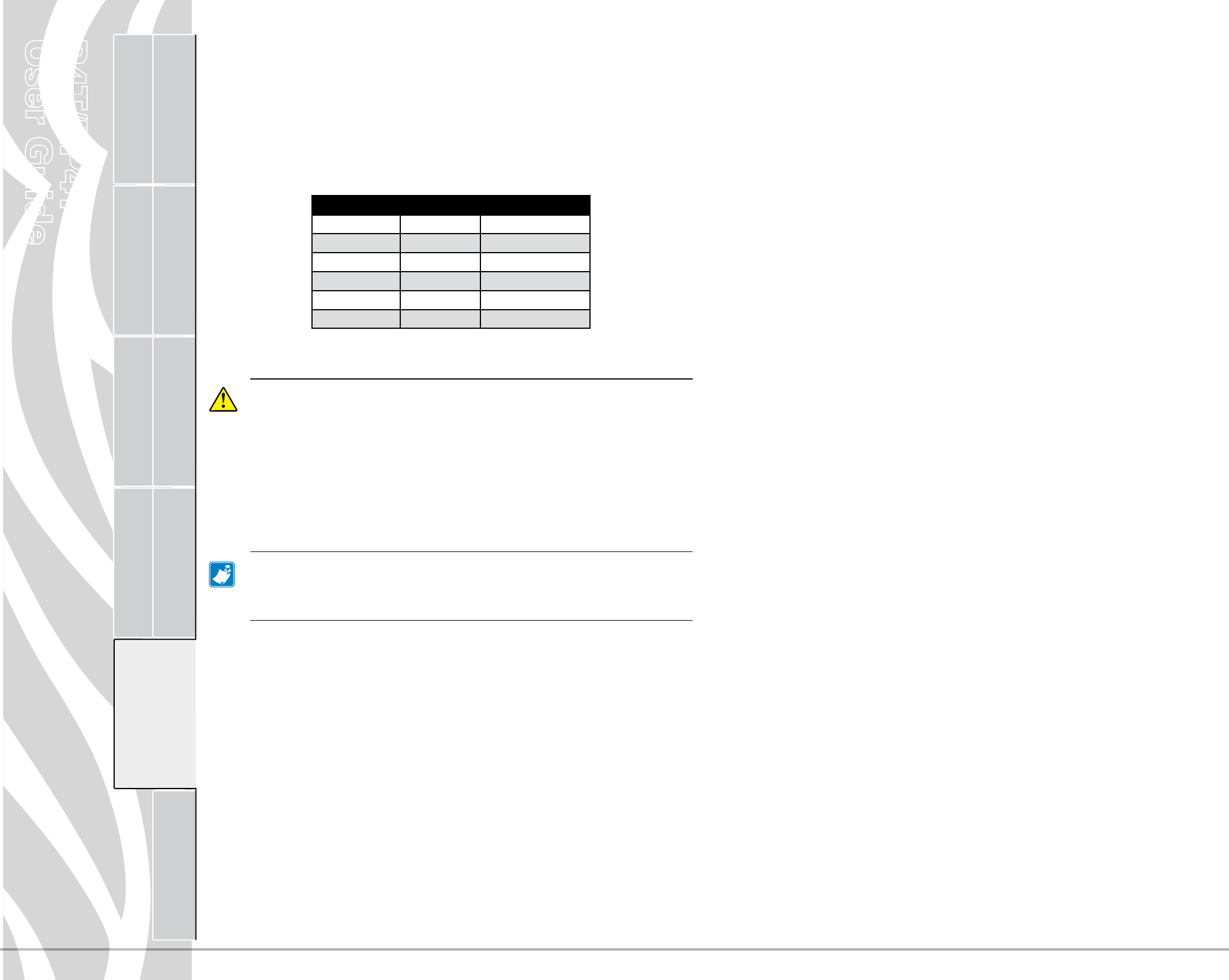
P4T/RP4T
User Guide
30
Printer Preparation Connecting the
Printer
Radio Regulatory
Information
RP4T Printers Maintenance Troubleshooting Specifications Appendices Index
P4T Overview
Manual
Introduction
RFID Encoder
ThefollowingsectiononlyapplieswhentheRFIDencoderisin-
stalledinanRP4Tprinter.TheRFIDencodermaybeinstalledincon-
junctionwitheithertheBluetoothor802.11gradiooptionsdetailed
previously, but may not be installed with the Bluetooth/802.11g
dual radio option.
P4T Series printers will have the fth character of the Product
CongurationCode(PCC)perthefollowingtable:
RFID option PCC digit “4” Printer Model
No RFID 0 P4T
US 1RP4T
EU 2RP4T
Japan 3 RP4T
China 4RP4T
Korea 5RP4T
UnitsbuiltfortheNorthAmericanregionwillalsohavethe(FCC
ID:TBD)onalabelonthebackoftheunit.
Caution • Use of a RP4T printer with the RFID Encoder
markedwithFCCID:TBDmeetstheFCCrequirementsfor
radio frequency (RF) radiation exposure in the standard
bodyworncongurationwithnominimumseparation.In
thiscongurationthefaceoftheprinterfromwhichpaper
is transported is facing away from the user’s body. The
standard conguration must always be used when the
printerisbodyworn.
The RP4T printer with this radio option has been
SAR tested. The maximum SAR value measured is:
TBDW/Kg(1gaverage